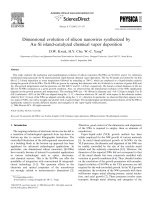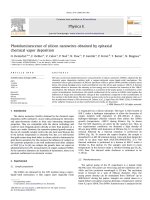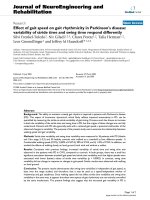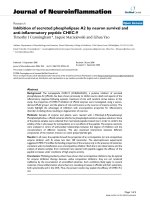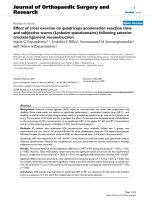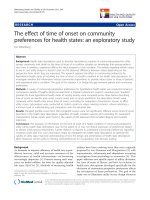Simultaneous effect of pH, deposition time, deposition potential, and step potential on the stripping peak current of lead and cadmium by response surface methodology
Bạn đang xem bản rút gọn của tài liệu. Xem và tải ngay bản đầy đủ của tài liệu tại đây (818.7 KB, 7 trang )
Tạp chí Khoa học & Công nghệ Số 6
21
Simultaneous effect of pH, deposition time, deposition potential,
and step potential on the stripping peak current of lead and cadmium
by response surface methodology
Thi Lieu Nguyen1,2,* , Van Hoang Cao2, Thi Dieu Cam Nguyen2, Thi Thanh Binh Nguyen2,
Quoc Trung Pham2,3, Truong Giang Le1,3
1
Graduate University of Science and Technology, Vietnam Academy of Science and Technology
Department of Chemistry, Quy Nhơn University
3
Institute of Chemistry, Vietnam Academy of Science and Technology
*
2
Abstract
In this paper, a simple voltammetric method has been reported for the lead, and cadmium
determination using platinum nanoflowers modified glassy carbon electrode (PtNFs/GCE). The effects
of pH, deposition time, deposition potential, step potential were investigated on the stripping peak
current of lead, and cadmium based on response surface methodology (RSM). The results of RSM
analysis and analysis of variance (ANOVA) have shown that the experimental data could be well
described by quadratic regression equations with determination coefficients (R2) of 0.935, and 0.972
for the stripping peak current of lead, and cadmium, respectively. Results of the statistical analysis
showed that the fit of the model was good in all cases. The maximum stripping peak current of the
lead, and cadmium of 5.54µA, and 2.81µA, respectively were obtained at the optimum levels of
process variables (pH (4.72), deposition potential (-1.14V), deposition time (120s), step potential
(7mV)). Testing the model to analyze lead, and cadmium on the PtNFs/GC electrode using differential
pulse anodic stripping voltammetry (DPASV) and obtained with the stripping peak current of the lead,
and cadmium of 5.43µA, and 2.75 µA, respectively.
® 2019 Journal of Science and Technology - NTTU
1 Introduction
Nowadays, the contamination of water by heavy metal ions
has become one of the main environmental problems[1]. The
wastewaters released from industries such as mining,
milling, plating, oil refining, metallurgy, storage batteries,
fertilizer production, textile dyeing, and alloy industries
contain many heavy metal ions, which widely enter the
environment without adequate treatment processes[2].
Heavy metals at higher concentrations can be dangerous and
can accumulate in living tissues, causing various diseases[3].
Lead and cadmium pollution is an urgent environmental
problem because of the complexity of their mechanisms of
biological toxicity and stability in contaminated sites. Lead
and cadmium accumulated in the body once absorbed and
Nhận
20.05.2019
Được duyệt 18.06.2019
Công bố
26.06.2019
Keyword
Pb2+, Cd2+, PtNFs/GCE,
Response surface
methodology, DPASV
endanger the health of humans[4]. A number of popular
methods, including isotope dilution, inductively coupled
plasma mass spectrometry (ID ICP-MS)[5], and flame
atomic absorption spectrometry (FAAS)[6], have been used
for the determination of lead and cadmium in different
aqueous solution. Most of the reported methods are the high
cost of equipment and maintenance, complicated operation,
time-consuming and require special sample preparation. For
these reasons, the rapid, simple and accurate method is
expected to be established.
Among of different analytical methods, electrochemical
methods are commonly used for the determination of heavy
metal ions, because of their ease of operation, low cost, high
sensitivity, and the ability to analyze elemental speciation.
Đại học Nguyễn Tất Thành
Tạp chí Khoa học & Công nghệ Số 6
22
Particularly, modification of electrode surfaces is one of the
important developments in recent years because
modification of the electrode surfaces significantly increases
the sensitivity along with a considerable decrease in
detection limit and interfering effects. The use of
nanoelectrodes in the field of electrochemical sensors has
become an interesting trend in electrochemical research
because of their advantages such as increased mass transport,
rapid electron transfer and high surface-to-volume ratio[7,8].
The catalytic activity of platinum nanoparticles in the
electrochemical analysis was investigated by Yoon et al.[9]
by blending Pt nanoparticles with carbon powder and
organic binder for electrode manufacture. This modified
electrode improved the copper peak current which is three
times higher than that measured on the non-modified
electrode.
Hence, we studied to develop a new, simple and sensitive
platinum nanoflowers modified glassy carbon electrode for
the determination of lead, and cadmium. Response surface
methodology (RSM) is a collection of statistical and
mathematical techniques useful for developing, improving,
and optimizing processes[10]. Response surface
methodology was used to obtain optimum experimental
conditions such as pH, deposition time, deposition potential,
step potential.
2 Material and methods
2.1 Material
2.1.1 Reagents
H2PtCl6.6H2O (Merck); H2SO4 (Merck); CH3COOH
(Merck); CH3COONa (Merck); Lead, and Cadmium stock
solution (1000 ppm), purchased from Merck was used for
dilution. All chemicals were of analytical grade and distilled
water was used for preparing all of the solutions.
2.1.2 Apparatus
Electrochemical measurements were performed using an
Autolab CPA–HH5 (Vietnam Academy of Science and
Technology) and three-electrode system with platinum
nanoflowers modified glassy carbon electrode (PtNFs/GCE)
as working electrode, an Ag/AgCl reference electrode and a
platinum wire counter electrode were used to perform
electrochemical measurements. Field-emission scanning
electron microscope (FE-SEM, S–4800, Hitachi Company,
Japan) was employed to evaluate the morphologies of the
PtNFs/GCE.
2.2 Method
The electrodeposition of platinum nanoparticles on the bare
glassy carbon electrode was carried out in 0.1 M H 2SO4
solution containing 1.0 mM H2PtCl6 at a constant potential
of -0.2V.
Following that, the PtNFs/GCE was gently cleaned with
distilled water before use. Detection of Pb 2+ (10μg.L-1) and
Cd2+ (10μg.L-1) were performed by different pulse anodic
stripping voltammetry (DPASV) in an acetate buffer solution
0.1M. The potential was scanned from -1.2V to +0.2V with
pulse amplitude 0.060V; pulse time 0.050 s; step time 0.03
s. In order to enhance the measurement sensitivity, the
parameters influencing the stripping peak current were
optimized to achieve the required sensitivity. pH, deposition
time, deposition potential, step potential were optimized and
used in the recommended procedure. All experiments
described in this section were performed at room
temperature (25 ± 10C).
The statistical software MODDE 12.1 trial (Umetrics,
Sweden) was used to create the experimental design,
statistical analyses, and regression model. RSM based on
quadratic and cubic models with central composite
circumscribed design (CCC) is composed of full factorial
design and star points (star distance: = 2). It has been used
to study the simultaneous effects of independent variables
(pH, deposition time, deposition potential, step potential) on
response functions.
The four independent variables pH, deposition time (s),
deposition potential (V), step potential (mV) (were coded
with X1, X2, X3, and X4, respectively, and each independent
variable had five levels (Table 1)). The real value of the
variable was related to the coded variable by the formula (1):
X - X0
Coded variable =
(1)
λ
Where X0 is the real value of variables at the central level,
and λ is the step change of the variable. The experiments with
coded and real values of the variables are shown in Table 1.
Table 1 Experimental range and levels of the independent variables
Symbol
Variable
X1
pH
-
3.5
-1
4.0
0
4.5
1
5.0
+
5.5
X2
tdep (s)
60
90
120
150
180
X3
E (V)
-1.3
-1.2
-1.1
-1.0
-0.9
X4
U (mV)
4
6
8
10
12
Đại học Nguyễn Tất Thành
Coded variable and Independent variables
Tạp chí Khoa học & Công nghệ Số 6
23
The response functions (Y1, Y2) are the stripping peak
current of lead, and cadmium, respectively. The relationship
between the response functions and the coded variables is
presented by a second-degree polynomial (2):
Y = β0 + βi ∑Xi + βii ∑X2i + βij ∑Xi Xj
(2)
Where Y is a response function; Xi and Xj are independent
variables; β0 is a constant; βi, βii, βij are linear, quadric, and
interactive
coefficients,
respectively.
Thirty-one
combinations along with 7 replicates of the central point
were formed, corresponding to 24 experiments.
3 Result and discussion
3.1 Surface Morphology of PtNFs/GCE
The surface morphology of PtNFs/GCE was investigated by
microscopic imaging analysis. Figure 1 shows the typical
SEM image of Pt layer electrodeposited on GCE at -0.2 V of
potential and 150 s of deposition duration. As can be seen in
the SEM image that Pt was formed separately on the GCE
(lighter areas) in nanoflowers shape with size varies in the
range (50 – 400 nm).
Fig. 1 SEM image of PtNFs/GCE deposited at a potential
of -0.2 V for 150 s
3.2 Fitting the model
The 4-factors CCC matrix predicted values and experimental
results for the stripping peak current response of lead and
cadmium were presented in Table 2. These results were used
for statistical analysis and to predict the regression equation
with the software MODDE 12.1 trial.
Table 2 The RSM experiment design matrix and experimental results
Exp
Run
order
1
2
3
4
5
6
7
8
9
10
11
12
13
14
15
16
17
18
19
20
21
22
23
24
25
26
27
14
9
21
29
3
18
16
23
10
17
1
13
22
15
31
8
2
20
25
27
28
30
11
4
7
26
24
Coded variable
X1
-1
1
-1
1
-1
1
-1
1
-1
1
-1
1
-1
1
-1
1
-2
2
0
0
0
0
0
0
0
0
0
X2
-1
-1
1
1
-1
-1
1
1
-1
-1
1
1
-1
-1
1
1
0
0
-2
2
0
0
0
0
0
0
0
X3
-1
-1
-1
-1
1
1
1
1
-1
-1
-1
-1
1
1
1
1
0
0
0
0
-2
2
0
0
0
0
0
X4
-1
-1
-1
-1
-1
-1
-1
-1
1
1
1
1
1
1
1
1
0
0
0
0
0
0
-2
2
0
0
0
Stripping peak current
of lead (IPb) (µA)
Experiment
Predicted
3.14
3.30
3.86
3.96
5.79
5.87
6.56
6.53
2.08
2.40
2.79
3.07
4.68
4.97
5.36
5.63
1.84
2.45
2.66
3.11
4.54
5.01
5.39
5.67
1.69
1.55
2.15
2.21
3.87
4.11
4.18
4.77
3.81
3.30
5.12
4.62
2.62
2.21
7.93
7.34
5.21
4.65
3.31
2.86
4.76
4.53
3.59
2.81
5.22
5.51
5.58
5.51
5.41
5.51
Stripping peak current of
cadmium (ICd) (µA)
Experiment
Predicted
1.73
1.74
1.98
2.04
2.74
2.87
3.08
3.17
1.56
1.46
1.75
1.76
2.49
2.58
2.87
2.88
1.57
1.58
1.8
1.88
2.58
2.70
2.91
3.00
1.41
1.30
1.61
1.60
2.31
2.42
2.69
2.72
1.84
1.79
2.49
2.39
1.28
1.38
3.88
3.62
2.49
2.26
1.62
1.69
2.59
2.52
2.28
2.20
2.74
2.74
2.60
2.74
2.78
2.74
Đại học Nguyễn Tất Thành
Tạp chí Khoa học & Công nghệ Số 6
24
28
29
30
31
6
5
12
19
0
0
0
0
0
0
0
0
0
0
0
0
0
0
0
0
5.82
5.01
5.64
5.90
5.51
5.51
5.51
5.51
2.71
2.68
2.84
2.82
2.74
2.74
2.74
2.74
statistical Student’s (t-test) was used to evaluate the
significance of the regression coefficients. The quadratic
regression equation of response functions for the stripping
peak current of lead (Eq.3), and cadmium (Eq.4) were
obtained after removing insignificant regression coefficients.
3.3 Develop model and statistic analysis
These results were used for statistical analysis and to predict
the regression equation with the software MODDE 12.1 trial.
The regression coefficient values for the coded variables of
the polynomial functions are shown in Table 3. The
Table 3 Regression coefficients values (coded variables) of the polynomial model of responses for the stripping peak current
of lead, and cadmium
For the stripping peak current of lead (µA)
Coeff.
Std.Err.
t-test
p-value
For the stripping peak current of cadmium (µA)
Coeff.
Std. Err.
t-test
p-value
2.739
0.050
86.530
1.24E-19a
βo
5.511
0.190
45.589
2.90E-15
β1
0.331
0.103
5.065
0.0053a
0.150
0.027
8.771
4.36E-05a
β2
1.283
0.103
19.631
1.14E-09a
0.561
0.027
32.792
5.36E-13a
β3
-0.449
0.103
6.875
0.00047a
-0.143
0.027
8.381
7.09E-05a
β4
-0.428
0.103
6.557
0.00072a
-0.081
0.027
4.726
0.0086a
β11
-0.387
0.094
6.480
0.00079a
-0.163
0.025
10.388
6.36E-06a
β22
β33
β44
-0.185
-0.439
-0.460
0.094
0.094
0.094
3.097
7.337
7.692
0.046a
0.00026a
0.00016a
-0.059
-0.190
-0.095
0.025
0.025
0.025
3.767
12.143
6.080
0.030a
9.23E-07a
0.0014a
β12
0.0063
0.126
0.078
0.97ins
0.035
0.033
1.673
0.31 ins
β13
-0.063
0.126
0.782
0.63 ins
0.000
0.033
9.75E-06
1 ins
β14
-0.028
0.126
0.344
0.83 ins
-0.001
0.033
0.060
0.97 ins
β23
-0.088
0.126
1.095
0.50 ins
-0.012
0.033
0.597
0.71 ins
β24
-0.055
0.119
0.126
0.126
0.688
1.486
0.667 ins
0.359 ins
-0.004
0.001
0.033
0.033
0.179
0.060
0.91 ins
0.97 ins
β34
a
Note: “Std. Err” standard error; asignificant at p <0.05; insinsignificant
Table 4 Analysis of variance (ANOVA) test for the response function
The stripping peak
current of lead, and
cadmium (μA)
For Lead
For Cadmium
Source
Regression
Residual
Pure error
Lack of Fit
Total cor.
Regression
Residual
Pure error
Lack of Fit
Total cor.
df
SS
MS
Fvalue
Fcritical
P-value
8
22
6
16
30
8
22
6
16
30
64.616
4.514
0.615
3.899
69.129
10.483
0.303
0.0421
0.260
10.785
8.077
0.205
0.102
0.244
2.304
1.310
0.014
0.007
0.016
0.360
39.368
1.994
<0.001
2.381
3.938
0.145
95.293
1.994
0.000
2.321
3.938
0.152
Note: “df” degree of freedom; “SS” sum of squares; “MS” means of squares; “Fvalue” fisher distribution;
“Fcritical” fisher critical; “Total cor” Total corrected
Đại học Nguyễn Tất Thành
Tạp chí Khoa học & Công nghệ Số 6
The result Table 3 indicates four variable independents (X1,
X2, X3, X4) signification (P-value < 0.05) but noticed that X2
variables greater than X1, X3, X4 about statistical
signification (P-value <<0.05). Besides interaction quadratic
X12, X22, X32, X42 also signification of the statistics. The
response for the second-order polynomial is given as
follows:
Y1 = 5.511+0.331X1 + 1.283X2 -0.449X3-0.428X40.388X12-0.185X22-0.439X32-0.460X42 (3)
Y2 = 2.739+0.150X1 + 0.561X2 -0.143X3-0.081X40.163X12-0.059X22-0.190X32-0.0953X42 (4)
The evaluation of the coefficient signs provides rapid
analysis of the parametrical effects of the model variables on
the responses. Negative coefficients point out unfavorable
effects for the stripping peak current the components X3, X4,
X12, X22, X32, X42 in polynomial Y1, Y2. Positive coefficients
refer to favorable effects on the stripping peak current for the
components X1, X2. However, it is recommended to further
evaluate the statistical significance of the predictors and
developed models using the ANOVA at level 95%
confidence intervals for the stripping peak current (μA) as
shown in Table 4.
3.4 Analysis of variance (ANOVA)
Analysis of variance was used to evaluate the suitability of
the regression equation with empirical. The result ANOVA
for Y model was indicated in Table 4.
The statistical significance of the model is confirmed by the
determination coefficient (R2), the adjusted determination
coefficient (R2adj), and the Fisher distribution (Fvalue). The
results clearly illustrate the high value of the coefficient of
determination (R2=0.935 and R2.adj = 0.911 for the stripping
peak current of lead). This means that 93.5% of the
variability for lead analysis process can be clarified by the
independent variables. And R2 = 0.972 and R2.adj = 0.962 for
the stripping peak current of cadmium, this means that 97.2%
of the variability for cadmium analysis process can be
clarified by the independent variables. The lack of fit was
also calculated to measure how the model fits the data. Thus,
the P-values of the lack of fit for the stripping peak current
of lead, and cadmium were 0.145, and 0.152, respectively.
25
An insignificant lack of fit (P > 0.05) at level 95% confidence
is a desirable property because it suggests the model fits the
data well. The calculated Fvalue for the full quadratic
regression equations of the stripping peak current response
of lead, and cadmium are 2.381, and 2.321, respectively (< F
(0.95, 16, 6) = 3.938), indicating that the model fits well with
experimental data. The results of ANOVA show that the
quadratic regression equation models for the stripping peak
current response of lead, and cadmium have good statistical
validation for predicting experiments with a valid
concentration region.
3.5 Response surface 3D, optimization conditions
To study the influence of experimental variables (pH,
deposition time, deposition potential, and step potential) on
the stripping peak current of lead, and cadmium, three
dimensional (3D) surfaces for the predicted responses were
drawn and accessible in Fig. 2.
Based on Eq. (2), the response surface plots were developed
and illustrated in Fig.2. The effect of deposition time variable
on the response function is indicated Fig 2a, 2d, 2f. The
stripping peak current increased with increasing deposition
time. As increasing the deposition time, more Pb2+, and Cd2+
will be deposited and adsorbed onto the surface of the
PtNFs/GCE, then stripping signal will increase. With
increasing pH, the stripping peak increased initially and then
decreased at higher pH, as shown in Fig 2a, 2b, 2c. Possibly
because in the low pH, metal exists as a weak link (labile
form) so it can be reduced and accumulated easily on the
electrode surface. In the high pH, metal can be in the form of
strong bonds (bound form) so is difficult to be eliminated. As
a result, less efficient enrichment happens, leading to the
lower stripping peak current. Particularly, the sensitivities
obtained from the pH values of 4.5 and 4.75 show almost a
similar current. Figure 2b, 2d, 2e showed that the effect of
deposition potential variable on the response function. It was
observed that the stripping peak current increased as
deposition potential was changed from -1.0 V to -1.15 V and
then it decreased. The stripping peak current increase as the
step potential increases up to 7 mV and then the peak current
declined slightly as shown in Fig 2c, 2e, 2f.
Đại học Nguyễn Tất Thành
Tạp chí Khoa học & Công nghệ Số 6
26
Fig. 2 Response surface showing electrochemical response as a function of two independent variables: (a) pH (X 1) and deposition
time (X2); (b) pH (X1) and deposition potential (X3); (c) pH (X1) and step potential (X4); (d) deposition time (X2) and deposition
potential (X3); (e) deposition potential (X3) and step potential (X4); (f) deposition time (X2) and step potential (X4)
The experimental results were optimized by software MODDE
12.1 trial using the approximating functions of stripping peak
current response in Eq. (2). Using highest stripping peak current
and lowest relative standard deviation as the optimization target,
the optimized condition was obtained as follow: pH of 4.72,
deposition potential (-1.14 V), deposition time (120 s), step
potential (7 mV) and its application in the determination of lead
and cadmium in real water samples. In addition, the interference
of some metal ions, surfactants on the stripping peak current will
be investigated in the further studies.
Fig. 3 Comparison modeling and experiment
The comparison in the optimal conditions between predicted
and observed values of response was investigated (Fig.3).
Đại học Nguyễn Tất Thành
Observed values were the measured data from the
experiment and the predicted values were calculated by
using Eq. (3), and Eq. (4). In this run, the stripping peak
current of lead, and cadmium were 5.54 (μA), and 2.81 (μA),
respectively as observed value, while predicted value were
5.43 (μA), and 2.75 (μA), respectively. The results
confirmed that the predicted value was in good agreement
with the observed value and the model performance was
validated.
4 Conclusion
Response surface methodology (RSM) was applied for
determining and optimizing the variables (pH, deposition
time, deposition potential, step potential). The simultaneous
effects of four above parameters on the stripping peak
current of lead and cadmium are represented in a quadratic
regression equation with statistical significance in the
experimental region. The model was extracted with R2 of
0.935, and 0.972 for lead and cadmium, respectively.
Analysis variance was used to evaluate the suitability of the
regression equation with empirical. ANOVA result shows
the model has good data. Finally, results from this method
indicated that pH of 4.72, deposition potential (-1.14 V),
deposition time (120 s), and step potential (7 mV) results in
the maximum current.
Tạp chí Khoa học & Công nghệ Số 6
27
References
1. M. Chen, X. Qin, G. Zeng, J. Li. J. Ma, G. Qin, Y. Zhang, J. Sun, S. Wang, and L. Jiang. Heavy metal removal from aqueous
solutions by calcium silicate powder from waste coal fly-ash. J. Clean. Prod., 2018, 182: p. 776–782.
2. C. Duran, A. Gundogdu, V. Numan, and M. Soylak. Solid-phase extraction of Mn (II), Co (II), Ni (II), Cu (II), Cd (II) and
Pb (II) ions from environmental samples by flame atomic absorption spectrometry ( FAAS ). Journal of Hazardous Materials,
2007, 146: p.347–355.
3. Z. Dahaghin, P. A. Kilmartin, and H. Z. Mousavi. Simultaneous determination of lead(II) and cadmium(II) at a glassy carbon
electrode modified with GO@Fe3O4@benzothiazole-2-carboxaldehyde using square wave anodic stripping voltammetry. J.
Mol. Liq., 2018, 249: p. 1125–1132.
4. A. Anna, M. Wojciechowski, M. Kalabun, and E. Bulska. Reference measurements of cadmium and lead contents in
candidates for new environmental certified materials by isotope dilution inductively coupled plasma mass spectrometry.
Microchem. J., 2018, 142: p.36–42.
5. M. Soylak. Enrichment-separation and determinations of cadmium (II) and lead (II) -1-phenyl-1 H -tetrazole-5-thiol chelates
on Diaion SP-207 by solid phase extraction-flame atomic absorption spectrometry. Arab. J. Chem., 2012,1–6.
6. Q. Shen, L. Jiang, H. Zhang, Q. Min, W. Hou, and J. Zhu. Three-dimensional Dendritic Pt Nanostructures:
Sonoelectrochemical Synthesis and Electrochemical Applications. The Journal of Physical Chemistry C, 2008, 112, p. 16385–
16392.
7. E. Jung, Y. Shin, M. Lee, J. Yi, and T. Kang. Interfacial Synthesis of Two-Dimensional Dendritic Platinum Nanoparticles
Using Oleic Acid-in-Water Emulsion. ACS Applied Materials & Interfaces, 2015, 7: p.10666-10670.
8. J. Yoon, G. Muthuraman, J. Yang, Y. Shim, and M. Won. Pt-Nanoparticle Incorporated Carbon Paste Electrode for the
Determination of Cu (II) Ion by Anodic Stripping Voltammetry. Electroanalysis, 2007, 19: p.1160–1166.
9. M. Almeida, R. Erthal, E. Padua, L. Silveira, and L. Am. Response surface methodology (RSM) as a tool for optimization
in analytical chemistry. Talanta, 2008, 76: p.965–977.
Nghiên cứu ảnh hưởng đồng thời của pH, thời gian điện phân, thế điện phân làm giàu và bước
nhảy thế đến cường độ dòng đỉnh hòa tan của chì và cadimi bằng phương pháp đáp ứng bề mặt
Thi Lieu Nguyen1,2,*, Van Hoang Cao2, Thi Dieu Cam Nguyen2, Thi Thanh Binh Nguyen2,
Quoc Trung Pham2,3, Truong Giang Le1,3
1
Graduate University of Science and Technology, Vietnam Academy of Science and Technology
Department of Chemistry, Quy Nhơn University
3
Institute of Chemistry, Vietnam Academy of Science and Technology
*
2
Tóm tắt Trong bài báo này, một phương pháp Von - ampe hòa tan đơn giản đã được báo cáo cho xác định chì và cadimi sử
dụng điện cực là các bông hoa nano platin biến tính trên nền cacbon thủy tinh (PtNFs/GCE). Ảnh hưởng của pH, thời gian
điện phân, thế điện phân làm giàu và bước nhảy thế đến cường độ dòng đỉnh hoàn tan cuả chì và cadimi đã được nghiên cứu
bằng phương pháp đáp ứng bề mặt (RSM). Kết quả phân tích RSM và phân tích phương sai ANOVA đã chỉ ra rằng dữ liệu
thực nghiệm có thể được mô tả bằng phương trình hồi qui bậc hai với hệ số xác định (R2) là 0,935, 0,972 cho xác định chì và
cadimi tương ứng. Cường độ dòng đỉnh hòa tan của chì, cadimi đạt cực đại theo mô hình là 5.54µA, and 2.81µA tại giá trị tối
ưu của các yếu tố pH (4,72), thế điện phân làm giàu (-1,14 V), thời gian điện phân (120 s) và bước nhảy thế (7 m V). Chúng
tôi thử nghiệm phân tích Pb(II), Cd(II) trên điện cực PtNFs/GCE bằng phương pháp Von – ampe hòa tan anot xung vi phân
với điều kiện của mô hình và kết quả thu được cường độ dòng đỉnh hòa tan của chì, cadimi là 5.43µA, and 2.75µA.
Từ khóa Pb2+, Cd2+, PtNFs/GCE, phương pháp đáp ứng bề mặt, DPASV.
Đại học Nguyễn Tất Thành


